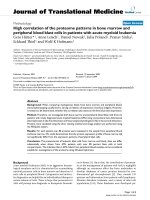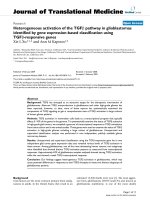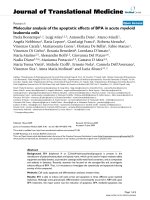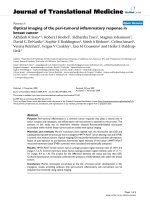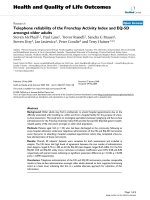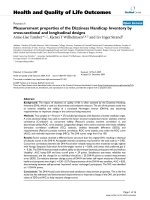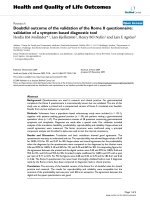báo cáo hóa học: " Telephone reliability of the Frenchay Activity Index and EQ-5D amongst older adults" pptx
Bạn đang xem bản rút gọn của tài liệu. Xem và tải ngay bản đầy đủ của tài liệu tại đây (425.63 KB, 8 trang )
BioMed Central
Page 1 of 8
(page number not for citation purposes)
Health and Quality of Life Outcomes
Open Access
Research
Telephone reliability of the Frenchay Activity Index and EQ-5D
amongst older adults
Steven McPhail
1,2
, Paul Lane
1
, Trevor Russell
2
, Sandra G Brauer
2
,
Steven Urry
3
, Jan Jasiewicz
3
, Peter Condie
3
and Terry Haines*
4,5
Address:
1
Princess Alexandra Hospital, Ipswich Road, Woolloongabba, Queensland, Australia,
2
The University of Queensland, School of Health
and Rehabilitation Sciences, St Lucia, Queensland, Australia,
3
Queensland University of Technology, Victoria Park Road, Kelvin Grove,
Queensland, Australia,
4
Southern Health, Allied Health Research Unit, Kingston Centre, Cnr Warrigal and Kingston Roads, Cheltenham, Victoria,
Australia and
5
Monash University, Physiotherapy Department, School of Primary Health Care, Monash University Peninsular Campus, Victoria,
Australia
Email: Steven McPhail - ; Paul Lane - ; Trevor Russell - ;
Sandra G Brauer - ; Steven Urry - ; Jan Jasiewicz - ;
Peter Condie - ; Terry Haines* -
* Corresponding author
Abstract
Background: Older adults may find it problematic to attend hospital appointments due to the
difficulty associated with travelling to, within and from a hospital facility for the purpose of a face-
to-face assessment. This study aims to investigate equivalence between telephone and face-to-face
administration for the Frenchay Activities Index (FAI) and the Euroqol-5D (EQ-5D) generic health-
related quality of life instrument amongst an older adult population.
Methods: Patients aged >65 (n = 53) who had been discharged to the community following an
acute hospital admission underwent telephone administration of the FAI and EQ-5D instruments
seven days prior to attending a hospital outpatient appointment where they completed a face-to-
face administration of these instruments.
Results: Overall, 40 subjects' datasets were complete for both assessments and included in
analysis. The FAI items had high levels of agreement between the two modes of administration
(item kappa's ranged 0.73 to 1.00) as did the EQ-5D (item kappa's ranged 0.67–0.83). For the FAI,
EQ-5D VAS and EQ-5D utility score, intraclass correlation coefficients were 0.94, 0.58 and 0.82
respectively with paired t-tests indicating no significant systematic difference (p = 0.100, p = 0.690
and p = 0.290 respectively).
Conclusion: Telephone administration of the FAI and EQ-5D instruments provides comparable
results to face-to-face administration amongst older adults deemed to have cognitive functioning
intact at a basic level, indicating that this is a suitable alternate approach for collection of this
information.
Published: 29 May 2009
Health and Quality of Life Outcomes 2009, 7:48 doi:10.1186/1477-7525-7-48
Received: 27 January 2009
Accepted: 29 May 2009
This article is available from: />© 2009 McPhail et al; licensee BioMed Central Ltd.
This is an Open Access article distributed under the terms of the Creative Commons Attribution License ( />),
which permits unrestricted use, distribution, and reproduction in any medium, provided the original work is properly cited.
Health and Quality of Life Outcomes 2009, 7:48 />Page 2 of 8
(page number not for citation purposes)
Background
Improving functional independence and health-related
quality of life are two common and inter-related goals of
health care services. These objectives are particularly
important for services that cater for the needs of older
adults. Evaluation of these services and ongoing monitor-
ing of their patients requires that participation in func-
tional activities and health-related quality of life be
measured with an approach that is amenable to the clini-
cal context. [1-3] A difficulty with evaluating these con-
structs is that many older adults find it difficult to attend
hospitals or other health care settings for appointments.
This is often due to the difficulty associated with travelling
to, within and from a hospital facility for the purpose of a
face-to-face assessment.[4,5] A viable alternative may be
to complete relevant survey instruments via a telephone
interview.
Different modes of administration of a range of self-
reported outcomes have previously been investigated in a
number of clinical populations. [6-15] Some of these
investigations have found that equivalent responses were
yielded from the different modes of administration [6-
10], while others have found that responses were depend-
ent on the mode of administration (such as self-com-
pleted postal surveys versus face-to-face administration)
[11-15]. However, in order for telephone administration
to be employed, it is important to demonstrate that equiv-
alent answers would be elicited from respondents regard-
less of whether the mode of survey administration was
face-to-face or via the telephone. This study aims to inves-
tigate equivalence between telephone and face-to-face
administration of the Frenchay Activities Index[16] (FAI)
and the Euroqol-5D[17] (EQ-5D) amongst sample of
older adults who are accessing health care services. There
have been no previous investigations of agreement
between telephone and face-to-face administration of
these instruments amongst older adults.
Methods
Design
Equivalence investigation between telephone and face-to-
face administration for the FAI and the EQ-5D.
Participants and setting
Older adults taking part in a larger evaluation of a novel
home-based rehabilitation program following discharge
from hospital participated in this study. Any person over
the age of 65 years of age discharged from the geriatric
rehabilitation, medical and surgical units of the Princess
Alexandra Hospital during the study period were available
for inclusion. Participants were excluded from the study if
they had severe cardiac disease (unstable angina), cogni-
tive impairment (Mini-Mental State Examination[18,19]
score <23/30), restricted weight bearing status (non or
partial weight bearing), aggressive behaviour, or referral
for post-discharge community rehabilitation services.
Measures
The FAI is a 15 item report of participation in functional
activities recently undertaken by the respondent. Each of
the 15 items require the participant to select one of four
possible responses that best describes their recent level of
participation in each nominated activity. Although the
four possible responses varied between items, they gener-
ally ranged between 'never' and a more frequent response
such as 'most days' or 'at least once weekly'. The longest
time a respondent is required to recall is during item 11
which refers to the frequency of travel for the purpose of
pleasure (for example a coach or rail trip) within the past
6 months. Each response was scored between zero (least
frequent level of participation) and 3 (most frequent level
of participation). An overall score out of 45 is calculated
by summing each of the individual item scores. Evidence
of sound validity and reliability have previously been
reported for this instrument. [20-22]
The EQ-5D is a generic health-related quality of life meas-
urement instrument consisting of 5 multiple choice ques-
tions, and a 100 point overall health state visual analogue
scale (VAS). [17] The first 5 questions relate to mobility,
personal care, usual activities, pain/discomfort and anxi-
ety/depression respectively. The respondent is required to
select one of three ordinal statements (e.g. no problems,
some problems, unable) which best describes their health
state in relation to these 5 domains. The responses from
these 5 questions can be converted to a utility score where
0 and 1 represent death and perfect health respectively. To
calculate the EQ-5D utility score the application of tariffs
previously derived from population based surveys investi-
gating preferences for all possible health state combina-
tions is undertaken. The Dolan formula was used for
utility calculation in this investigation[23]. Evidence of
sound validity and reliability have previously been
reported for this instrument. [17,24-30]
During telephone administration questions were read
directly from the FAI and EQ-5D instruments. The first
five EQ-5D questions were read verbatim as per telephone
instructions [31], while the EQ-5D VAS component was
modified slightly from the original version with a repeti-
tion of the question (for wording of EQ-5D VAS script see
Additional file 1).
Procedure
Hospital physiotherapists identified potential partici-
pants meeting the inclusion criteria who were about to be
discharged from the hospital between March and Decem-
ber 2007 and sought verbal consent for the patient to be
approached by a project research assistant. Pending this
Health and Quality of Life Outcomes 2009, 7:48 />Page 3 of 8
(page number not for citation purposes)
consent, the research assistant then provided a full
description of the project to the patient and then sought
written informed consent for participation. The research
assistant then collected demographic information, includ-
ing the FAI, EQ-5D and the Activity-specific Balance Con-
fidence Scale[32] (a measure of how confident
participants feel they can complete functional tasks with-
out falling) prior to the patient being discharged from
hospital.
Participants completed the FAI and EQ-5D via telephone
interview with a research assistant (PL) seven days prior to
an eight week post discharge outpatient review appoint-
ment at a tertiary hospital. The FAI and EQ-5D were then
completed again at the subsequent outpatient appoint-
ment seven days later where the measures were adminis-
tered face-to-face by the same research assistant. A seven
day period was chosen so that participants would have a
lower chance of remembering their response to the tele-
phone-administered survey items when the time came for
them to again complete the surveys via the face-to-face
administration approach. A longer period was not chosen
to minimise the risk that the participant's health would
change in a measureable way during the between-assess-
ment period.
This study was approved by the Human Research Ethics
Committee of the Princess Alexandra Hospital, and the
Medical Research Ethics Committee of The University of
Queensland.
Analysis
The Kappa statistic was used to describe the agreement
between assessment approaches for individual items
within the outcome measures examined. Confidence
intervals for kappa statistics were calculated using boot-
strap resampling (2000 replications of original sample
size)[33,34]. The number of exact matches was also calcu-
lated for each item. For FAI and EQ-5D items the fre-
quency of each possible response was computed to
identify whether responses were distributed across the
range of possible scores or whether they were at either end
of the scales (potentially indicating ceiling or floor effects
within an item).
FAI summative scores were calculated and EQ-5D
response items were converted to utility scores using the
Dolan formula.[23] Limits of agreement and intraclass
correlation coefficients (ICC) were calculated to investi-
gate agreement between assessment approaches for the
FAI summary score, EQ-5D VAS and EQ-5D utility score.
Paired t-tests were also employed to examine whether sys-
tematic differences between the two modes of administra-
tion existed for the FAI summary score, EQ-5D VAS and
EQ-5D utility scores. Bland-Altman plots[35] are also pre-
sented for the FAI summary score, and EQ-5D VAS and
utility scores.
Results
Sixty-eight patients were screened by the recruiting
research assistant after being referred by ward staff for
potential participation in the study. All sixty eight met the
inclusion criteria; however, fifteen did not provide
informed consent. Fifty-three patients consented to partic-
ipate. Forty subjects' datasets were complete for the FAI
and EQ-5D at both assessments and were included in the
analysis. Reasons for participants' incomplete sets of data
excluded from analysis included unable to attend face-to-
face reassessment on scheduled appointment day (8), not
able to be contacted via telephone seven days prior to
reassessment (3), readmitted to hospital with acute illness
at time of assessment (1) and death (1). Participant demo-
graphics for patients included in analysis are displayed in
Table 1. A high proportion of participants (90%) required
a walking aid when outside their home and a substantial
Table 1: Participant demographics
Participants who complete both modes of administration n = 40
Age – mean (sd) 79 (7.3)
Male 17 (42.5%)
Diagnosis category for recent hospital admission
Orthopaedic 15 (37.5%)
Neurological 6 (15%)
Non-specific disabling impairment 12 (30%)
All other diagnoses combined 7 (17.5%)
English as first language 32 (80%)
Walking aid when outside home
Nil 4 (10%)
Walking Stick/s 13 (32.5%)
4 Wheeled walking frame 21 (52.5%)
Other – Non-wheeled Walking aid 2 (5%)
The Activities-specific Balance Confidence Scale mean (sd) no confidence = 0 complete confidence = 100 54 (20)
Health and Quality of Life Outcomes 2009, 7:48 />Page 4 of 8
(page number not for citation purposes)
level of concern about falling over was present amongst
this population.
Levels of agreement, and 95% confidence intervals,
between telephone and face-to-face administration of the
FAI and EQ-5D items are displayed in Table 2. For 11 out
of 15 items of the FAI, kappa was >0.80 and was between
0.60 and 0.80 for the remaining 4 items. Similarly kappa
for each of the EQ-5D domain items were either between
0.60 and 0.80 (3/5) or >0.80 (2/5). Mean scores, p-values
from paired t-tests for differences in group means, limits
of agreement and intraclass correlation coefficients
between telephone and face-to-face administration for the
FAI summary score, and for the EQ-5D VAS and utility
scores are displayed in Table 3.
Two FAI items did not have participant answers distrib-
uted across the spectrum of responses. All (40) partici-
pants reported they did not undertake paid work while 33
reported that they never drive. The Bland-Altman plots for
the FAI summary score, and EQ-5D VAS and utility scores
are displayed (Figure 1) and do not indicate a relationship
between overall score and level of agreement between tel-
ephone and face-to-face administration.
Table 2: Level of agreement (kappa) and frequency of exact matches between face-to-face and telephone administration of the
Frenchay Activities Index and the EQ-5D items
Level of agreement
kappa (95% CI)
Frequency of exact matches
(% out of 40)
Frenchay Activity Index items
Prepare main meals 0.85
(0.68,0.97)
35
(88%)
Wash up 0.91
(0.82,0.98)
36
(90%)
Wash clothes 0.88
(0.70,0.98)
36
(90%)
Light housework 0.88
(0.72,1.00)
37
(93%)
Heavy housework 0.96
(0.87,1.00)
38
(95%)
Local shopping 0.89
(0.74,0.98)
36
(90%)
Social outing 0.73
(0.53,0.88)
30
(75%)
Walk outside >15 mins 0.73
(0.49,0.92)
33
(83%)
Active interest in hobby 0.78
(0.61,0.92)
33
(83%)
Drives/taxi/bus 1
(-,-)
40
(100%)
Outings/car ride 0.73
(0.39,0.93)
35
(88%)
Gardening 0.85
(0.73,0.96)
35
(88%)
Housework or car maintenance 0.92
(0.78,1.00)
38
(95%)
Reading books 0.83
(0.71,0.94)
32
(80%)
Gainful work 1
(-,-)
40
(100%)
EQ-5D items
Mobility 0.67
(0.39,0.85)
33
(83%)
Personal care 0.87
(0.64,1.00)
38
(95%)
Usual activities 0.72
(0.48,0.90)
34
(85%)
Pain/discomfort 0.67
(0.45,0.86)
32
(80%)
Anxiety/depression 0.83
(0.64,0.96)
36
(90%)
Health and Quality of Life Outcomes 2009, 7:48 />Page 5 of 8
(page number not for citation purposes)
Discussion
The FAI and EQ-5D generally had high levels of agree-
ment between telephone and face-to-face administration
of these instruments at both the individual item level and
overall score. Within the EQ-5D instrument, the intraclass
correlation coefficients and limits of agreement (Table 3)
indicated agreement was lower for the VAS, than for the
utility score. Greater variability within the VAS score is not
surprising given its sensitivity to smaller amounts of
change that might occur over a one week period relative to
the discrete response items that combine to form the util-
ity score.[36,37] While it is logical that some differences
between modes of administration for the VAS may be, in
part, attributable to the absence of visual representation of
the scale during phone administration, agreement
between responses from the two modes of administration
for these instruments is comparable to test-retest reliabil-
ity investigations for each the EQ-5D [24-27] and FAI [20-
22] instruments where the same mode of administration
was used at each assessment. This further strengthens the
argument that telephone administration of these instru-
ments is valid. In the same way, the mean differences, lim-
its of agreement and paired t-tests indicate that although
some variation existed between responses from each
assessment for each instrument, no systematic difference
was present. The high levels of agreement between the two
modes of administration at the individual item level and
overall scores indicate that telephone administration of
these instruments is a valid method of obtaining this
information from elderly patients in the community. The
ability to collect this survey based information via the tel-
ephone offers viable and potentially more efficient and
convenient approach to face-to-face assessment amongst
older adults with cognition intact at a basic level.
The findings from this investigation are in line with previ-
ous reports of high levels of agreement between modes of
administration for other related instruments [6-10]. Previ-
ous investigations which have not found high levels of
agreement between modes of administration for survey
instruments have often compared self-completed to inter-
view administered modalities [11-15]. The high levels of
agreement between the two modes of administration
found in this investigation may be explained by similar
nature of telephone and face-to-face administration of a
survey instrument in comparison to self-completion.
A study of this nature will always have two key potential
limitations that need to be counterbalanced. First is the
risk that a participant may have anticipated the purpose of
this study, recalled their original answer and responded in
the same way when completing the questionnaires for the
second time. Second is the risk that a participant's health
may have measurably changed between the two assess-
ment points. We believe that this study was more at risk of
the second limitation than the first as we allowed a seven
day washout period between assessments. This, combined
with the shear number of items that a respondent would
have had to remember correctly gave some protection
against the memory-recall limitation. By doing so how-
ever, our results were likely to be more conservative than
what could be expected in real life. Hence, given the
nature of our design, we argue that the results of this
investigation provide evidence that telephone administra-
tion of the FAI and EQ-5D (utility and VAS) instruments
could be validly used in research or clinical practice.
The extrapolation of results from this investigation is lim-
ited somewhat as we focused our investigation solely
upon older adults who are accessing health care services.
Notably though, it is this population for whom telephone
assessment of the constructs of participation in functional
activities and health-related quality of life may be most
important. We did however exclude participation by older
adults with cognitive impairment as assessed by a Mini-
Mental State Examination score of <23 out of 30. It is pos-
sible that older adults with cognitive impairment may not
respond as consistently between the two administration
approaches as our study sample did. Similarly some par-
ticipants who were unable to attend the appointment to
Table 3: Intraclass correlation coefficient (ICC), mean scores, and limits of agreement (LOA) between telephone and face-to-face
administration of the Frenchay Activity Index (FAI) and EQ-5D
Limits of agreement
Measure ICC
(95% CI)
telephone
mean (95% CI)
face-to-face
mean (95%CI)
Lower LOA
(95% CI)
Mean difference
(95% CI)
Upper LOA
(95% CI)
p-value*
FAI – total 0.94
(0.89, 1.00)
18.7
(15.8, 21.6)
19.6
(16.8, 22.4)
-7.4
(-8.5, -6.4)
-0.9
(-1.9, 0.2)
5.7
(4.7, 6.7)
0.100
EQ-5D VAS 0.58
(0.23, 0.93)
67.6
(62.6, 72.7)
68.3
(63.0, 73.7)
-22.8
(-26.3, -19.3)
0.7
(-2.8, 4.2)
21.4
(17.9, 24.9)
0.690
EQ-5D utility 0.82
(0.65,0.98)
0.643
(0.559, 0.728)
0.619
(0.528, 0.709)
-0.268
(-0.314, -0.222)
-0.025
(-0.071, 0.022)
0.317
(0.271, 0.363)
0.290
Note: *a p-value < 0.05 indicates that a systematic difference exists (i.e. telephone responses were either consistently higher or consistently lower
than face-to-face responses)
Health and Quality of Life Outcomes 2009, 7:48 />Page 6 of 8
(page number not for citation purposes)
Bland Altman plots for Frenchay Activity Index (a), EQ-5D VAS (b) and EQ-5D utility (c)Figure 1
Bland Altman plots for Frenchay Activity Index (a), EQ-5D VAS (b) and EQ-5D utility (c).
Health and Quality of Life Outcomes 2009, 7:48 />Page 7 of 8
(page number not for citation purposes)
complete the face-to-face assessment may have had
poorer health than those participants with complete data-
sets resulting in a slightly healthier sample. Along these
lines, the study did not include many patients with poor
to very poor self-rated health-related quality of life as a
majority of responses were greater than 40 out of 100 on
the VAS (Figure 1). It is possible that people with poor to
very poor self-rated health may not respond as consist-
ently between the two administration approaches as our
study sample did. It is also noteworthy that some FAI
items such as gainful work are likely to have low variance
amongst older adult populations (as many are retired).
Items like this may have exceptionally high levels of agree-
ment, at least in part, due to a floor effect. Within this
investigation this applied to both items with perfect agree-
ment (gainful work and driving). However one could rea-
son that the low variance observed in this investigation
may often be present within these items amongst
responses from this type of population. Thus the high
level of agreement observed between modalities for these
items may be reflective of what would occur in clinical,
epidemiological and research settings that utilise these
instruments amongst older adults.
Future investigations may consider the validity of tele-
phone administration of other survey based instruments
for the elderly as a way of reducing the burden of health
assessments amongst this population. The ability to com-
plete survey based instruments such as the FAI and EQ-5D
via the telephone is likely to increase the feasibility of fol-
lowing up elderly patients in both clinical and research
environments.
Conclusion
This study has indicated that telephone and face-to-face
administration of the Frenchay Activity Index and EQ-5D
yields comparable responses amongst older adults with
cognition intact at a basic level.
Competing interests
The authors declare that they have no competing interests.
Authors' contributions
All authors contributed to the conception of research idea
and planning of process. PL contributed to data collec-
tion. SM contributed to data analysis. SM and TH were
involved in manuscript preparation. All authors contrib-
uted to manuscript review, appraisal and editing.
Additional material
Acknowledgements
We would like to acknowledge the Queensland Health Community Reha-
bilitation Grant Scheme for their support of this project.
References
1. Kind P: Measuring quality of life in evaluating clinical interven-
tions: an overview. Ann Med 2001, 33(5):323-327.
2. Hickey A, Barker M, McGee H, O'Boyle C: Measuring health-
related quality of life in older patient populations: a review of
current approaches. Pharmacoeconomics 2005, 23(10):971-993.
3. McPhail S, Beller E, Haines T: Two perspectives of proxy report-
ing of health-related quality of life using the Euroqol-5D, an
investigation of agreement. Med Care 2008, 46(11):1140-1148.
4. Forrest CB, Starfield B: Entry into primary care and continuity:
the effects of access. American journal of public health 1998,
88(9):1330-1336.
5. Allsup SJ, Gosney MA: Difficulties of recruitment for a rand-
omized controlled trial involving influenza vaccination in
healthy older people. Gerontology 2002, 48(3):170-173.
6. Pinto-Meza A, Serrano-Blanco A, Penarrubia MT, Blanco E, Haro JM:
Assessing depression in primary care with the PHQ-9: can it
be carried out over the telephone? J Gen Intern Med 2005,
20(8):738-742.
7. Barker RN, Amsters DI, Kendall MD, Pershouse KJ, Haines TP: Reli-
ability of the clinical outcome variables scale when adminis-
tered via telephone to assess mobility in people with spinal
cord injury. Archives of physical medicine and rehabilitation 2007,
88(5):632-637.
8. Maisto SA, Conigliaro JC, Gordon AJ, McGinnis KA, Justice AC: An
experimental study of the agreement of self-administration
and telephone administration of the Timeline Followback
interview. J Stud Alcohol Drugs. 2008, 69(3):468-471.
9. Aziz MA, Kenford S: Comparability of telephone and face-to-
face interviews in assessing patients with posttraumatic
stress disorder. Journal of psychiatric practice 2004, 10(5):307-313.
10. Verghese J, Katz MJ, Derby CA, Kuslansky G, Hall CB, Lipton RB:
Reliability and validity of a telephone-based mobility assess-
ment questionnaire.
Age Ageing 2004, 33(6):628-632.
11. McHorney CA, Kosinski M, Ware JE Jr: Comparisons of the costs
and quality of norms for the SF-36 health survey collected by
mail versus telephone interview: results from a national sur-
vey. Med Care 1994, 32(6):551-567.
12. Bowling A: Mode of questionnaire administration can have
serious effects on data quality. Journal of public health (Oxford, Eng-
land) 2005, 27(3):281-291.
13. Grootendorst PV, Feeny DH, Furlong W: Does it matter whom
and how you ask? inter- and intra-rater agreement in the
Ontario Health Survey. J Clin Epidemiol 1997, 50(2):127-135.
14. Bowling A, Bond M, Jenkinson C, Lamping DL: Short Form 36 (SF-
36) Health Survey questionnaire: which normative data
should be used? Comparisons between the norms provided
by the Omnibus Survey in Britain, the Health Survey for
England and the Oxford Healthy Life Survey. Journal of public
health medicine 1999, 21(3):255-270.
15. Hanmer J, Hays RD, Fryback DG: Mode of administration is
important in US national estimates of health-related quality
of life. Med Care 2007, 45(12):1171-1179.
16. Holbrook M, Skilbeck CE: An activities index for use with stroke
patients. Age and ageing 1983, 12(2):166-170.
Additional file 1
Verbal description for EQ-5D VAS (italicized text indicates wording
has been added to or adapted from the original EQ-5D text to facili-
tate phone administration).
Click here for file
[ />7525-7-48-S1.doc]
Publish with BioMed Central and every
scientist can read your work free of charge
"BioMed Central will be the most significant development for
disseminating the results of biomedical research in our lifetime."
Sir Paul Nurse, Cancer Research UK
Your research papers will be:
available free of charge to the entire biomedical community
peer reviewed and published immediately upon acceptance
cited in PubMed and archived on PubMed Central
yours — you keep the copyright
Submit your manuscript here:
/>BioMedcentral
Health and Quality of Life Outcomes 2009, 7:48 />Page 8 of 8
(page number not for citation purposes)
17. Rabin R, de Charro F: EQ-5D: a measure of health status from
the EuroQol Group. Ann Med 2001, 33(5):337-343.
18. Folstein M, Folstein S, McHugh P: Mini-Mental State: a practical
method for grading the cognitive state of patients for the cli-
nician. Journal of Psychiatric Research 1975, 12:189-198.
19. Tombaugh T, McIntyre N: The mini-mental state examination:
a comprehensive review. Journal of the American Geriatrics Society
1992, 40:922-935.
20. Turnbull JC, Kersten P, Habib M, McLellan L, Mullee MA, George S:
Validation of the Frenchay Activities Index in a general pop-
ulation aged 16 years and older. Archives of physical medicine and
rehabilitation 2000, 81(8):1034-1038.
21. Green J, Forster A, Young J: A test-retest reliability study of the
Barthel Index, the Rivermead Mobility Index, the Notting-
ham Extended Activities of Daily Living Scale and the
Frenchay Activities Index in stroke patients. Disability and reha-
bilitation 2001, 23(15):670-676.
22. Piercy M, Carter J, Mant J, Wade DT: Inter-rater reliability of the
Frenchay activities index in patients with stroke and their
careers. Clinical rehabilitation 2000, 14(4):433-440.
23. Dolan P, Roberts J: Modelling valuations for Eq-5d health
states: an alternative model using differences in valuations.
Med Care 2002, 40(5):442-446.
24. Unal G, de Boer JB, Borsboom GJ, Brouwer JT, Essink-Bot M, de Man
RA: A psychometric comparison of health-related quality of
life measures in chronic liver disease. Journal of clinical epidemi-
ology 2001, 54(6):587-596.
25. Fransen M, Edmonds J: Reliability and validity of the EuroQol in
patients with osteoarthritis of the knee. Rheumatology (Oxford,
England) 1999, 38(9):807-813.
26. Dorman P, Slattery J, Farrell B, Dennis M, Sandercock P: Qualitative
comparison of the reliability of health status assessments
with the EuroQol and SF-36 questionnaires after stroke.
United Kingdom Collaborators in the International Stroke
Trial. Stroke; a journal of cerebral circulation 1998,
29(1):63-68.
27. Hurst NP, Kind P, Ruta D, Hunter M, Stubbings A: Measuring
health-related quality of life in rheumatoid arthritis: validity,
responsiveness and reliability of EuroQol (EQ-5D). British jour-
nal of rheumatology 1997, 36(5):551-559.
28. Coons SJ, Rao S, Keininger DL, Hays RD: A comparative review
of generic quality-of-life instruments. PharmacoEconomics 2000,
17(1):13-35.
29. Konig HH, Ulshofer A, Gregor M, von Tirpitz C, Reinshagen M, Adler
G, Leidl R: Validation of the EuroQol questionnaire in patients
with inflammatory bowel disease. European journal of gastroenter-
ology & hepatology 2002, 14(11):1205-1215.
30. Schweikert B, Hahmann H, Leidl R: Validation of the EuroQol
questionnaire in cardiac rehabilitation. Heart (British Cardiac
Society) 2006, 92(1):62-67.
31. Brooks R: The measurement and valuation of health status
using EQ-5D: A European perspective. In Evidence from the Euro-
Qol BIO MED Research Programme Edited by: Brooks R, Rabin R, De
Charro F. Dordrecht: Kluwer Academic Publishers; 2003:271-274.
32. Powell LE, Myers AM: The Activities-specific Balance Confi-
dence (ABC) Scale. The journals of gerontology 1995,
50A(1):M28-34.
33. Efron B, Tibshirani R: An introduction to the bootstrap. New
York: Chapman and Hall; 1993.
34. Lee J, Fung KP: Confidence interval of the kappa coefficient by
bootstrap resampling. Psychiatry Res 1993, 49(1):97-98.
35. Bland JM, Altman DG: Statistical methods for assessing agree-
ment between two methods of clinical measurement. Lancet
1986, 1(8476):307-310.
36. Krabbe PF, Peerenboom L, Langenhoff BS, Ruers TJ: Responsive-
ness of the generic EQ-5D summary measure compared to
the disease-specific EORTC QLQ C-30. Qual Life Res 2004,
13(7):1247-1253.
37. Wu AW, Jacobson KL, Frick KD, Clark R, Revicki DA, Freedberg KA,
Scott-Lennox J, Feinberg J: Validity and responsiveness of the
euroqol as a measure of health-related quality of life in peo-
ple enrolled in an AIDS clinical trial. Qual Life Res 2002,
11(3):273-282.
